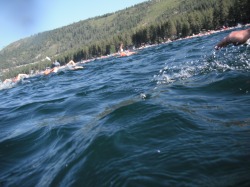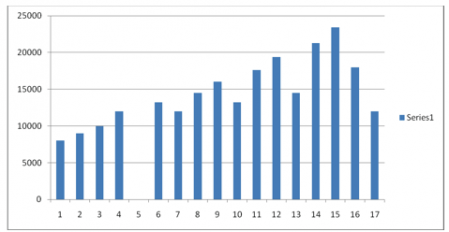Training Suggestions for 8k OW Swim
by Head Coach of Swim Las Vegas, Paul Fritz
Every endurance athlete is different in many ways, their natural ability, goals, technique, body composition and mental capacity. Each swimmer is coached according to and including all of these differences. A “One Size Fits All” approach is not used when training for endurance swimming; however, some basic/general concepts/methods will be incorporated and applied to every swimmer.
The goal for endurance swimming is to maximize aerobic capacity, even if it means compromising muscular power and anaerobic capacity to a degree. Open Water (OW) endurance swimmers will swim far more miles/yards each week than a triathlete and a regular masters swimmer. The additional swimming each week will be at threshold and overload endurance training; however, the majority and most important part of training will be done at the basic endurance level. For competitive OW swimmers and serious distance swimmers a total volume of 60,000 yards/meters each week is standard.
Every endurance athlete is different in many ways, their natural ability, goals, technique, body composition and mental capacity. Each swimmer is coached according to and including all of these differences. A “One Size Fits All” approach is not used when training for endurance swimming; however, some basic/general concepts/methods will be incorporated and applied to every swimmer.
The goal for endurance swimming is to maximize aerobic capacity, even if it means compromising muscular power and anaerobic capacity to a degree. Open Water (OW) endurance swimmers will swim far more miles/yards each week than a triathlete and a regular masters swimmer. The additional swimming each week will be at threshold and overload endurance training; however, the majority and most important part of training will be done at the basic endurance level. For competitive OW swimmers and serious distance swimmers a total volume of 60,000 yards/meters each week is standard.
The following chart illustrates the training zones percentages of the composition of yards/meters training for a week of endurance swimming at the peak training period.
Warm Up & Cool Down 10,000
GRAND TOTAL 59,000
Basic endurance training comprises the bulk of the training since it is not physically possible to train at anaerobic threshold day after day. It would be wonderful to train at Anaerobic Threshold (ANT) all the time but ANT training relies on muscle glycogen which is depleted in one-two days of ANT training. Since it takes time to rebuild your muscle glycogen stores, basic endurance training steps in and allows the body to recover glycogen stores while still training. This is completely dependent on your diet, but that is a topic for another article. Lactate Tolerance, Production and Power are all very minimal contributions since training too much above ANT decreases your overall ANT.
The goal for endurance swimming is to maximize aerobic capacity or swimming faster with less reliance on anaerobic metabolism so lactic acid will accumulate at a slower rate and acidosis will be delayed. Lactic acid builds in the muscles during training, kind of like rust forming on metal, it restricts muscular contraction. Too much lactic acid buildup (acidosis) and you will hit the proverbial wall or bonk. Ideally an endurance swimmer will achieve a level of activity where the production and removal of lactic acid will be equal at their greatest speed.
- Basic Endurance 30,000 62%
- Threshold Endurance 8,000 16%
- Overload Endurance 6,000 8%
- Lactate Tolerance 3,000 6%
- Lactate Production Power 1,000 2%
Warm Up & Cool Down 10,000
GRAND TOTAL 59,000
Basic endurance training comprises the bulk of the training since it is not physically possible to train at anaerobic threshold day after day. It would be wonderful to train at Anaerobic Threshold (ANT) all the time but ANT training relies on muscle glycogen which is depleted in one-two days of ANT training. Since it takes time to rebuild your muscle glycogen stores, basic endurance training steps in and allows the body to recover glycogen stores while still training. This is completely dependent on your diet, but that is a topic for another article. Lactate Tolerance, Production and Power are all very minimal contributions since training too much above ANT decreases your overall ANT.
The goal for endurance swimming is to maximize aerobic capacity or swimming faster with less reliance on anaerobic metabolism so lactic acid will accumulate at a slower rate and acidosis will be delayed. Lactic acid builds in the muscles during training, kind of like rust forming on metal, it restricts muscular contraction. Too much lactic acid buildup (acidosis) and you will hit the proverbial wall or bonk. Ideally an endurance swimmer will achieve a level of activity where the production and removal of lactic acid will be equal at their greatest speed.
Categories

Basic Endurance:
1. Set Distances from 2,000-10,000 yds/m
2. Repeat Distances: Any
3. Rest intervals: 5-30 secs
4. Speed: 2-4 sec. slower than ANT
Threshold Endurance: (ANT) Most effective training/most taxing training
1. Set Distances from 2,000-4,000 yds/m
2. Repeat Distances: 25-1000
3. Rest intervals: 10-30 secs (200’s or less) 60 secs (400’s+)
4. Speed: at ANT – intense training – max effort over entire set
Overload Endurance:
1. Set Distances from 1,500-2,000 yds/m
2. Repeat Distances: 25-500
3. Rest intervals: 30 secs – 2 min.
4. Speed: 2-3 sec. faster than ANT
Every endurance swimmer with a targeted goal OW swim should have a training plan laid out ahead of time to simplify training and mentally prepare them for the challenging road ahead. Done correctly OW endurance swimming training is not easy, but it is possible for all levels when properly planned. A basic overall plan for an 8K goal could be set up with a 12 week program including a 4 week base build.
1. Set Distances from 2,000-10,000 yds/m
2. Repeat Distances: Any
3. Rest intervals: 5-30 secs
4. Speed: 2-4 sec. slower than ANT
Threshold Endurance: (ANT) Most effective training/most taxing training
1. Set Distances from 2,000-4,000 yds/m
2. Repeat Distances: 25-1000
3. Rest intervals: 10-30 secs (200’s or less) 60 secs (400’s+)
4. Speed: at ANT – intense training – max effort over entire set
Overload Endurance:
1. Set Distances from 1,500-2,000 yds/m
2. Repeat Distances: 25-500
3. Rest intervals: 30 secs – 2 min.
4. Speed: 2-3 sec. faster than ANT
Every endurance swimmer with a targeted goal OW swim should have a training plan laid out ahead of time to simplify training and mentally prepare them for the challenging road ahead. Done correctly OW endurance swimming training is not easy, but it is possible for all levels when properly planned. A basic overall plan for an 8K goal could be set up with a 12 week program including a 4 week base build.
Building Your Plan
The 4 week base build would include 3-4 days per week of swimming at basic endurance training and build from 2000-4000 yds/m per swim session. The 12 week program would include 4-5 days per week and build from 4000-6000 yds/m per swim session and incorporate the above training concepts into each weekly workout. Each week will increase the overall volume by about 10% until the maximum desired weekly volume is achieved. The 12 week program would also include recovery weeks and taper weeks. The following graph illustrates the weekly yardage and the overall plan duration.
The above Chart is built from the following information:
Weekly Yds
8,000Base Week 1
9,000Base Week 2
10,000Base Week 3
12,000Base Week 4
13,200 Week 1
12,000 Week 2 (recovery)
14,500 Week 3
16,000 Week 4
13,200Week 5 (recovery)
17,600 Week 6
19,400 Week 7
14,500 Week 8 (recovery)
21,300 Week 9
23,400 Week 10
18,000 Week 11 (Taper)
12,000 Week 12 (Taper)
Weekly Yds
8,000Base Week 1
9,000Base Week 2
10,000Base Week 3
12,000Base Week 4
13,200 Week 1
12,000 Week 2 (recovery)
14,500 Week 3
16,000 Week 4
13,200Week 5 (recovery)
17,600 Week 6
19,400 Week 7
14,500 Week 8 (recovery)
21,300 Week 9
23,400 Week 10
18,000 Week 11 (Taper)
12,000 Week 12 (Taper)

